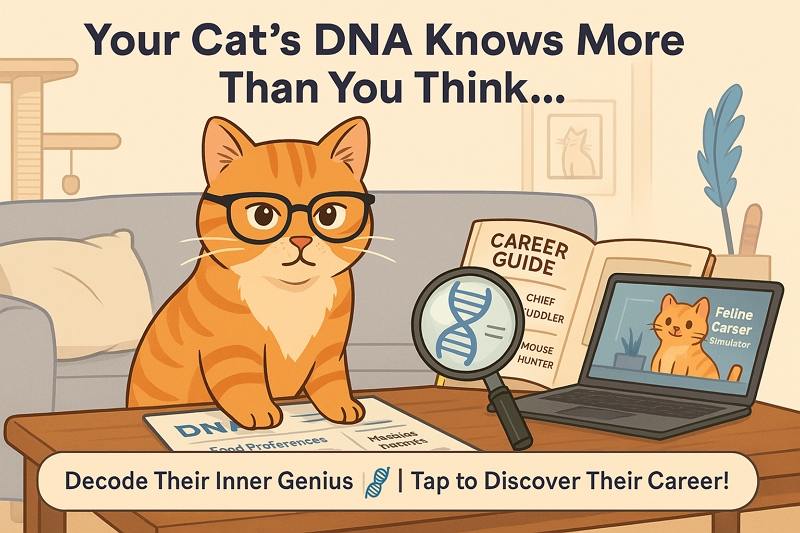Unlock Your Cat's Genetic Secrets: From Foodie Furball to Feline Career Prodigy
Have you ever wondered why Mr. Whiskers charges at the food bowl like it's his last meal on Earth? Or why Lady Mittens seems to vanish into stealth mode, only to pounce on a feather toy at lightning speed? It turns out, these antics aren't just random-they're written in your cat's DNA. Genetic testing for cats goes far beyond confirming if they're a Siamese or a Maine Coon. It can decode their taste preferences, play style, social tendencies, and even their "career potential" in the grand "meow-world" of feline professions.
Spoiler Alert: Your sofa-snoozer might carry the "Professional Napper" gene.
In this article, we'll explore how specific genes shape your cat's personality and behavior, introduce you to the concept of "feline career traits," share real-world success stories, and guide you through three interactive modules to reveal-and celebrate-your cat's genetic superpowers.

1. How Genes Shape Your Cat's Personality (and Appetite!)
Genes influence everything from your cat's fur color to the way they react to a can of tuna. In this section, we'll delve into three genetic categories that govern feeding behavior, activity levels, and social style.
1. The "Foodie" Gene: TAS2R and Taste Preferences
What it does: The TAS2R family of genes regulates bitter taste perception. Cats with certain variants are more sensitive to bitterness, making them picky eaters, while others are fearless garbage-dive connoisseurs.
Behavioral clue: If your cat sniffs at a new treat and walks away, they might have the "super-taster" variant. Conversely, if they gobble anything in sight, they likely carry a low-sensitivity allele.
2. Activity Level & Play Style: Hunting Instinct Genes
What it does:Genes related to dopamine signaling and muscle performance influence whether your cat is a "feather toy slayer" or a "lap potato."
Behavioral clue:The "predator" gene variant often correlates with high-intensity play-stalking, pouncing, and zoomies. The "relaxation" variant favors long naps and gentle kneading sessions.
3. Social Traits: Oxytocin Receptor and the "Velcro Cat"
What it does: Variants in the oxytocin receptor gene can affect bonding and attachment behaviors.
Behavioral clue: Cats with the high-affinity receptor variant often seek constant human contact, while others remain independent "lone wolves."
2. From "Dry Food Devotee" to "Feline CEO": Genes as Career Blueprints
Imagine if your cat had a professional résumé-tailored by DNA. In this playful analogy, we map genetic traits to "meow-world" careers. Science-backed, tongue-in-cheek, and utterly delightful.
Career Title
Key Genetic Traits
Skill Highlights
Chief Cuddle Officer
High oxytocin sensitivity + social-seeking allele
Purring therapy, expert kneading, lap occupancy
Head Mouse Patrol
Strong predator gene + elevated agility markers
Stealth ambush, lightning-fast chases, rodent defense
Creative Destruction Lead
Elevated curiosity gene + problem-solving DNA
Box exploration, cup-pushing artistry, puzzle-solving
Scientific Note: Studies from the University of Missouri and others have linked these behavioral phenotypes to identifiable genetic markers, illuminating how innate drives translate into everyday antics.
3. Real-Life Case Studies: From Test Results to "Cat Career" Triumphs
Meet two feline stars who've leveled up their lives thanks to genetic insights. Their stories showcase how understanding DNA can lead to happier, more fulfilling experiences for both cats and their humans.
Case Study 1: Garfield the Kitchen Supervisor
Genetic Insight: High "food vigilance" gene expression.
Behavior Before Testing: Garfield lounged lazily until dinner prep began-then he'd zoom in, meowing incessantly.
Outcome: Armed with his genetic profile, Garfield's owner created a "kitchen watch station" with a cozy perch and timed treat dispenser. Now, Garfield channels his food-focus into supervised culinary duties-earning him the official title of "Kitchen Supervisor."
Case Study 2: Luna the DIY Hunting Specialist
Genetic Insight: Elevated "prey drive" allele.
Behavior Before Testing: Luna brought random "gifts" (both real and imaginary) to her owner's feet, then ignored toys that didn't simulate real hunts.
Outcome: Luna's owner crafted custom hunting puzzles-feather lures hidden in cardboard mazes and motorized "prey" toys. Luna's happiness and engagement skyrocketed, validating the power of tailored play.
Case Study 3: "Shadow Operative" - Unleashing the Stealth Gene
Genetic Insight: High expression of "alert-stealth" genes
Behavior Before Testing: Shadow would lurk silently in corners, watching household traffic with laser focus but rarely initiating contact. His owner assumed he was aloof and uninterested in play.
Outcome: Armed with the knowledge of Shadow's stealth gene, the owner created a "Covert Ops Training Course" around the living room and study-hiding teaser toys in nooks and crannies for Shadow to detect and ambush. Shadow's innate surveillance and pouncing instincts were honored and encouraged through structured play. Shadow became noticeably more engaged and active. The "stake-out and strike" rhythm of the games strengthened his bond with his owner and reduced his anxiety.
Case Study 4: "The Maestro" - Tapping into the Sound Sensitivity Gene
Genetic Insight: Exceptionally high "auditory sensitivity" gene markers
Behavior Before Testing: Midi ignored everyday conversations but would instantly perk up at the first notes of classical or piano music-pacing, ear-twitching, and even "conducting" with a raised paw.
Outcome: Following the genetic report, the owner introduced a daily "Cat Concert Series," playing a variety of musical genres and observing Midi's reactions. They set up a mini "stage" with soft cushions in the living room and invited family members to "perform" Midi's favorite pieces. Midi blossomed into the household's resident "Maestro," tapping the floor in time with the music and even attempting simple vocalizations in sync with melodies.
Unlock Your Cat's Hidden Potential!
Ready to transform your understanding of your feline friend? Test your cat's genetic and embark on a journey of discovery-where science meets play, and every whisker twitch tells a story. Uncover the science behind your cat's quirkiest behaviors-from why they're the first to the food bowl to their hidden "professional" talents!






 HitPaw VoicePea
HitPaw VoicePea  HitPaw VikPea (Video Enhancer)
HitPaw VikPea (Video Enhancer) HitPaw FotorPea
HitPaw FotorPea



Share this article:
Select the product rating:
Daniel Walker
Editor-in-Chief
My passion lies in bridging the gap between cutting-edge technology and everyday creativity. With years of hands-on experience, I create content that not only informs but inspires our audience to embrace digital tools confidently.
View all ArticlesLeave a Comment
Create your review for HitPaw articles